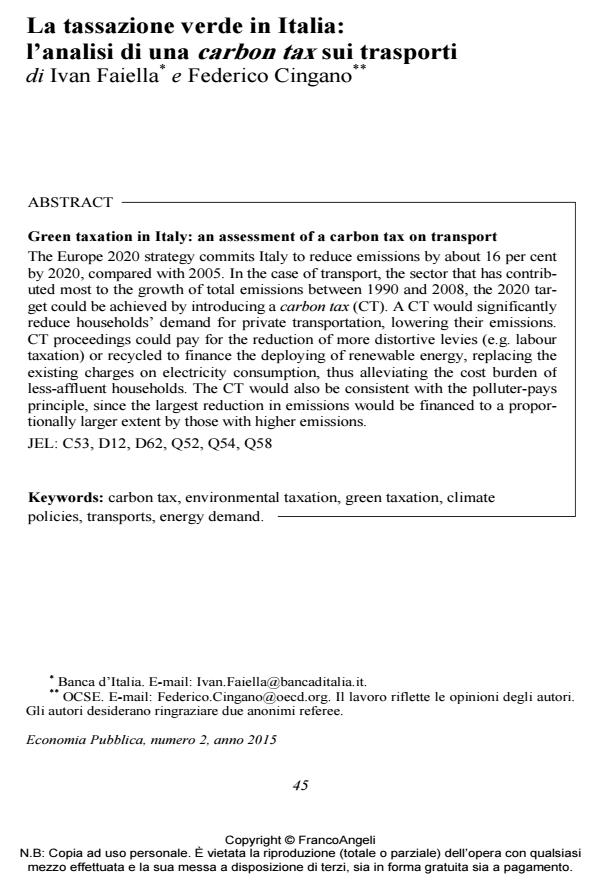Green taxation in Italy: an assessment of a carbon tax on transport
Journal title ECONOMIA PUBBLICA
Author/s Ivan Faiella, Federico Cingano
Publishing Year 2016 Issue 2015/2
Language Italian Pages 46 P. 45-90 File size 605 KB
DOI 10.3280/EP2015-002002
DOI is like a bar code for intellectual property: to have more infomation
click here
Below, you can see the article first page
If you want to buy this article in PDF format, you can do it, following the instructions to buy download credits

FrancoAngeli is member of Publishers International Linking Association, Inc (PILA), a not-for-profit association which run the CrossRef service enabling links to and from online scholarly content.
The Europe 2020 strategy commits Italy to reduce emissions by about 16 per cent by 2020, compared with 2005. In the case of transport, the sector that has contributed most to the growth of total emissions between 1990 and 2008, the 2020 target could be achieved by introducing a carbon tax (CT). A CT would significantly reduce households’ demand for private transportation, lowering their emissions. CT proceedings could pay for the reduction of more distortive levies (e.g. labour taxation) or recycled to finance the deploying of renewable energy, replacing the existing charges on electricity consumption, thus alleviating the cost burden of less-affluent households. The CT would also be consistent with the polluter-pays principle, since the largest reduction in emissions would be financed to a proportionally larger extent by those with higher emissions. Keywords: carbon tax, environmental taxation, green taxation, climate policies, transports, energy demand
Keywords: Carbon tax, environmental taxation, green taxation, climate policies, transports, energy demand
Jel codes: C53, D12, D62, Q52, Q54, Q58
- A Micro-founded Climate Stress Test on the Financial Vulnerability of Italian Households and Firms Ivan Faiella, Luciano Lavecchia, Alessandro Mistretta, Valentina Michelangeli, in SSRN Electronic Journal /2021
DOI: 10.2139/ssrn.3960005 - A climate stress test on the financial vulnerability of Italian households and firms Ivan Faiella, Luciano Lavecchia, Valentina Michelangeli, Alessandro Mistretta, in Journal of Policy Modeling /2022 pp.396
DOI: 10.1016/j.jpolmod.2021.11.001 - Vulnerable Households in the Energy Transition Ivan Faiella, Luciano Lavecchia, pp.173 (ISBN:978-3-031-35683-4)
- Una Nuova Misura Della Povertt Energetica Delle Famiglie (A New Measure of Households' Energy Poverty) Ivan Faiella, Luciano Lavecchia, Marco Borgarello, in SSRN Electronic Journal /2017
DOI: 10.2139/ssrn.3073102 - Carbon Tax acceptability: A comparative experimental analysis Lucia Rotaris, Alessandro Gardelli, in ECONOMICS AND POLICY OF ENERGY AND THE ENVIRONMENT 1/2019 pp.117
DOI: 10.3280/EFE2018-001005 - The carbon content of Italian loans Ivan Faiella, Luciano Lavecchia, in Journal of Sustainable Finance & Investment /2022 pp.939
DOI: 10.1080/20430795.2020.1814076 - To Eat or to Heat: Are Energy Bills Squeezing People's Spending? Andrea Colabella, Valentina Michelangeli, Luciano Lavecchia, Raffaella Pico, in SSRN Electronic Journal /2024
DOI: 10.2139/ssrn.4849271
Ivan Faiella, Federico Cingano, La tassazione verde in Italia: l’analisi di una carbon tax sui trasporti in "ECONOMIA PUBBLICA " 2/2015, pp 45-90, DOI: 10.3280/EP2015-002002